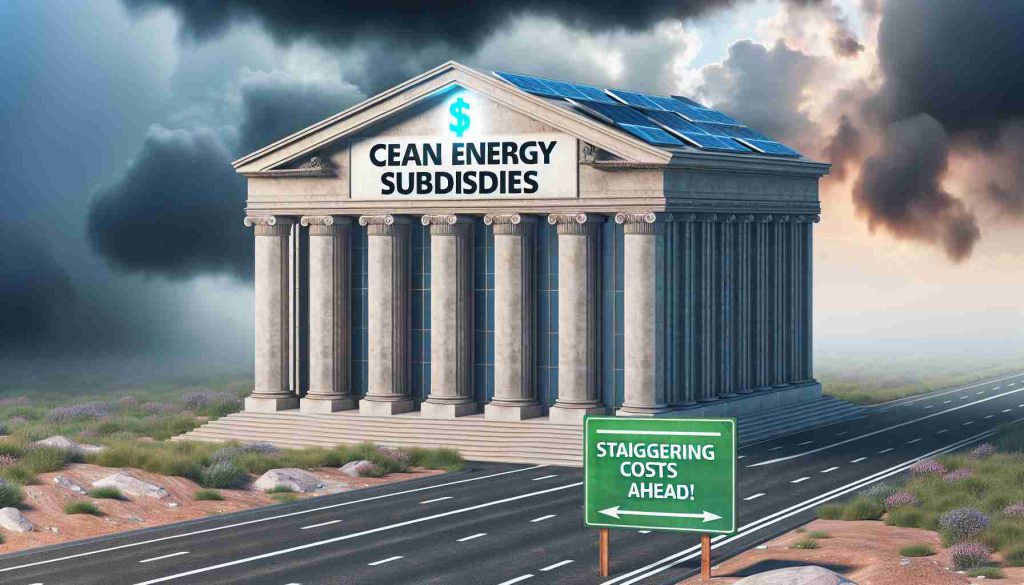Staggering Costs Ahead! Will Clean Energy Subsidies Break the Bank?
4 min read
The U.S. government, under President Joe Biden’s Inflation Reduction Act, is facing a potential increase in budget deficits by a staggering $825 billion over the next decade. This figure was disclosed by Philip Swagel, the director of the Congressional Budget Office, who highlighted the shocking revision from an earlier estimate of $270 billion.
Swagel explained that the substantial increase in projected costs stems from a change in the budget assessment period. The new evaluation spans from 2025 to 2035, which contrasts sharply with the original window from 2022 to 2031 when the act was passed in 2022. The latest analysis indicates that the financial implications of the clean energy tax subsidies are far-reaching and more burdensome than previously thought.
Moreover, the director pointed out that regulatory adjustments contributed to the soaring costs. Recent rule changes have led to a heightened demand for electric vehicle subsidies, notably through the introduction of leasing options and stricter tailpipe emissions standards aimed at internal combustion engine vehicles.
With these developments, the implications of the Inflation Reduction Act are becoming increasingly significant, prompting questions about long-term fiscal sustainability as the country pushes for a cleaner energy future. As the budget landscape evolves, stakeholders will watch closely how these subsidies impact the economy in the years to come.
Understanding the Broader Impact of Inflation Reduction Act Projections
The alarming rise in projected budget deficits under the Inflation Reduction Act (IRA) reveals not just fiscal concerns, but also profound implications for societal and cultural dynamics as the U.S. transitions towards a greener economy. As the government invests heavily in clean energy incentives, a broader conversation emerges about economic mobility and job creation within burgeoning industries. The shift to renewable energy resources could catalyze employment opportunities, yet it also poses challenges for workers in traditional sectors who may face displacement.
Furthermore, the global economy is likely to feel ripples from these policy changes. The U.S. commitment to sustainable energy could recalibrate international markets, particularly in the renewable sector, where investments in solar, wind, and electric vehicles are already on the rise. This transformation may spur innovation in related technologies and create competitive advantages, safeguarding the U.S. position in the global energy landscape.
However, the environmental repercussions of this drive towards electrification cannot be overlooked. Increased demand for electric vehicles and their associated infrastructure, while aimed at reducing greenhouse gas emissions, raises questions about resource extraction and the viability of battery materials. As trends towards sustainability evolve, balancing ecological impact with technological advancement will be essential for long-term success.
In summary, the implications of the Inflation Reduction Act projections extend beyond mere budgetary numbers; they signal a transformative era for U.S. society and the global economy, necessitating a careful examination of both opportunities and challenges ahead.
Inflation Reduction Act Costs Set to Skyrocket: What You Need to Know
Understanding the Budget Implications of the Inflation Reduction Act
The Inflation Reduction Act (IRA) of 2022, aimed at promoting clean energy and combating climate change, is now projected to increase U.S. budget deficits by an astounding $825 billion over the next decade. This revelation by Philip Swagel, director of the Congressional Budget Office (CBO), marks a significant upward revision from the initial estimate of $270 billion.
Key Factors Behind the Budget Deficit Increase
# 1. Extended Budget Assessment Period
The major factor contributing to this dramatic increase in projected costs is the extension of the budget assessment period. The latest evaluation covers the years from 2025 to 2035, diverging from the original analysis which considered the period between 2022 and 2031 when the IRA was enacted. This shift reflects broader fiscal impacts over a longer horizon, showcasing how initial projections can evolve.
# 2. Enhanced Demand for Electric Vehicle (EV) Subsidies
The current rules and regulatory adjustments have spurred greater demand for electric vehicle subsidies. The IRA introduced new leasing options and tighter emissions standards which incentivize consumers and manufacturers alike to pivot from traditional internal combustion engines to electric vehicles. The expanded scope of these subsidies is a flow-through effect of the desire for a greener economy but comes at a higher fiscal cost.
Pros and Cons of the Inflation Reduction Act
# Pros:
– Promotion of Clean Energy: The IRA incentivizes the shift towards renewable energy sources, thereby addressing climate change concerns.
– Job Creation: Initiatives to enhance clean energy technology are likely to generate numerous jobs in emerging fields.
# Cons:
– Increased Budget Deficits: The projected $825 billion increase raises questions about fiscal responsibility and sustainability.
– Regulatory Constraints: Stricter emissions standards might impose challenges for manufacturers and consumers who rely on traditional vehicle types.
Insights and Predictions for the Future
As the U.S. grapples with the financial implications of the IRA, important trends are emerging that will shape future climate policies and economic strategies:
– Increased Investment in Renewable Technologies: To counterbalance rising costs, there may be a surge in investment directed towards innovations in renewable technologies and energy efficiency.
– Potential for Legislative Revisions: As the fiscal landscape evolves, lawmakers may revisit aspects of the IRA to control costs while still advancing clean energy goals.
– Market Dynamics and Consumer Behavior: The shifting regulations and incentives may alter consumer behavior towards more sustainable choices but may also lead to increased resistance from consumers relying on conventional energy sources.
Industry Responses and Market Analysis
The auto and energy sectors are closely monitoring these developments. Auto manufacturers are increasingly investing in electric vehicle technology to comply with new standards, while energy companies reevaluate their investments in fossil fuels versus renewables.
Conclusion
The financial ramifications of the Inflation Reduction Act reveal a complex interplay between environmental objectives and fiscal sustainability. The projections signal a crucial juncture for the U.S. economy as stakeholders seek to balance the push for a cleaner future against the backdrop of potential budget crises.
For more information on sustainability initiatives and climate policies, visit EPA.



